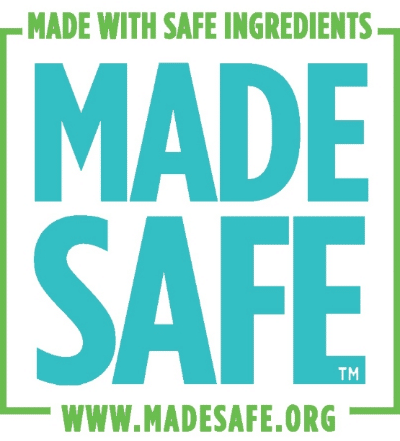This article was written by Amy Ziff, Founder and Executive Director of MADE SAFE.
A little over 5 years ago I had twins. More than my older daughter they were sensitive to everything. They were allergic to diapers and creams and ‘hypo-allergenic’ washes and lotions. They vomited when I breastfed them on “the” foam pillow I was supposed to be using. I couldn’t figure out what was making my kids sick. But I have a Masters in Journalism and started to research what was happening. What I learned about the products for sale in this country, the toxic chemicals in them, and the impact of those items on our health was horrifying.
It’s perfectly legal for chemicals linked to cancer, fertility problems, developmental harm, learning disabilities, and other serious diseases to be used in things we’re surrounded by every day. But the problem is that with scant legislation and little to no regulation around chemicals in commerce, many products that we use every day contain toxic chemicals that can seriously harm our health and the health of our families. In fact, the situation is so egregious that Dr. Philip Landrigan, a leading MD and Dean of Global Health at Mount Sinai School of Medicine, has said, “We’re conducting a vast toxicological experiment and we are using our children as experimental animals.”

The current system means that the burden is on us to try to figure out what’s safe and what’s not—and frankly, that’s nearly impossible for the average person unless you have a degree in toxicology.
I thought there had to be a better way, that we needed to take real steps to fundamentally change this system because our lives literally depend on it. And that was the inception of MADE SAFE™.
MADE SAFE is the first nontoxic certification in America verifying that finished products are made from a base of materials, components, and ingredients not known to harm human health or the environment. Unlike most seals, which tend to be category specific, MADE SAFE vets an array of categories to apply widely to things people use every day.
MADE SAFE certification is unique in many other ways too. Our approach is to work with companies at any stage in order to be a catalyst for better, healthier, more sustainable products in the marketplace. In order to do that, we work with companies under NDA in order to have full disclosure about what goes into their finished products, how they are sourcing materials and components, as well as where and how those materials are made. From there we take a 360-degree look at each material in a product to evaluate it through our scientific screening process.

 To start, we screen out known toxicants. MADE SAFE certified products don’t contain carcinogens, endocrine disruptors, fire retardants, GMOs, heavy metals, neurotoxins, pesticides, toxic solvents, or harmful VOCs. Those are nonstarters that we don’t permit in products.
To start, we screen out known toxicants. MADE SAFE certified products don’t contain carcinogens, endocrine disruptors, fire retardants, GMOs, heavy metals, neurotoxins, pesticides, toxic solvents, or harmful VOCs. Those are nonstarters that we don’t permit in products.
But we go beyond known toxic chemicals listed on authoritative “red lists” to assess for concerns for bioaccumulation, persistence, and general and aquatic toxicity using predictive modeling software. This approach allows us to consider human health, environmental, and ecosystem health when evaluating components of products.
We follow the Precautionary Principle: in cases where we can’t obtain enough data to determine that an ingredient won’t cause harm to human health, we don’t allow it in certified products.
The goal is to ensure that certified products are made from a base of safe ingredients that aren’t harmful which can help with supply chain pollution and improving work environments.
We work with companies during the research and development phase of formulation (and reformulation) to help develop MADE SAFE items from the start. These considerations are the future of green chemistry. We see the best-selling products of the future as ones designed for the growing segment of conscious consumers.
MADE SAFE certification makes it easy for people to identify and purchase things made without known toxic chemicals. It provides a much-needed road map to companies making better consumer goods. It also makes it easy for retailers to select products made without harmful ingredients.
At scale, we imagine a world where there are MADE SAFE certified electronics, cell phones, and even cars. It just takes one innovation to make a game-changing difference for a safer and sustainable world.
Here’s to our healthy future!
To follow our work sign up for our newsletter, and follow us on Facebook, Twitter, and Instagram as @madesafehq.
If you’re interested in working with MADE SAFE, contact Amy Ziff at info@madesafe.org.






![10 Steps Toward a Zero Energy Home [Infographic]](https://elemental.green/wp-content/uploads/2016/04/cbfb-440x264.jpg)

